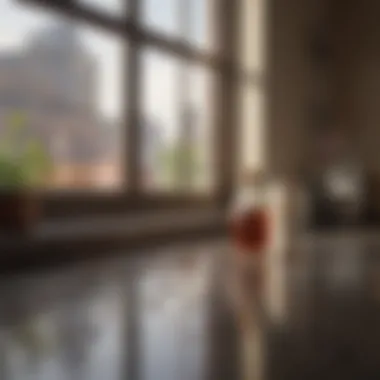Effective Strategies to Prevent Ants from Entering Windows


Intro
Ants are resilient creatures, often finding pathways into our homes, particularly through windows. Understanding how to effectively keep them at bay is essential for homeowners. This article delves into practical strategies rooted in science that can be deployed to prevent ant infiltration through windows. By analyzing their behavior and biology, homeowners can make informed choices about prevention methods.
In this guide, we will explore various preventive measures—including natural deterrents and structural changes—offering both short-term and long-term solutions for a pest-free home. A clean environment and regular monitoring play crucial roles in maintaining such an ant-free space. Understanding how ants operate is fundamental to the success of these strategies.
In summary, this rich discussion aims to equip readers with actionable knowledge to combat ant invasions effectively.
Understanding Ant Behavior
To effectively prevent ants from entering, it is vital to understand their behavior and biology. Ants are social insects that communicate and forage in organized colonies. They typically follow pheromone trails, which guide others to food sources or suitable nesting sites.
Key Factors to Consider:
- Pheromone Trails: Ants leave behind scent trails. If one ant finds food, others will follow.
- Food Sources: Crumbs, spills, or pet food can attract ants.
- Nesting Habits: Some species nest close to structures, making entry easier.
Prevention Techniques
Preventing ants from entering through windows involves a multi-faceted approach. Here are proven methods that can help:
Cleanliness is Key
Maintaining a clean environment is the first line of defense against ant invasions.
- Regular Cleaning: Wipe down surfaces, especially kitchen counters and dining areas.
- Food Storage: Use airtight containers for food products. Avoid leaving food exposed.
Sealing Entry Points
Identify and seal the entry points around your windows.
- Inspections: Regularly check for gaps, cracks, or wear in window frames.
- Sealant: Use caulk to fill gaps and cracks effectively. This deters ants from finding entry points.
Natural Deterrents
Utilizing natural ingredients can keep ants away without harmful chemicals.
- Vinegar Water Solution: Mix equal parts vinegar and water and spray around window frames. The strong scent disrupts their trails.
- Essential Oils: Oils such as peppermint or tea tree oil can be effective. Mix with water and spray regularly.
Structural Changes
Consider long-term modifications to your home to enhance its defenses against ants.
- Screens: Install fine mesh screens on windows to block access without hindering airflow.
- Regular Maintenance: Repair any damages to windows and frames, ensuring they are structurally sound.
End
In summary, keeping ants out of your home requires a blend of cleanliness, prevention tactics, and structural integrity. Understanding their behavior allows homeowners to implement effective measures. Regular inspections and maintenance, along with the use of natural deterrents, can significantly lower the risk of ant invasion through windows. With persistence and attention to detail, you can maintain an ant-free living environment, safeguarding your home from these resilient pests.
Preface to Ant Infestations
Understanding ant infestations is crucial for anyone wanting to maintain a pest-free environment within their home. Ants are social insects that form colonies, and they can quickly invade living spaces, particularly through windows. Recognizing the importance of preventing these incursions can save homeowners significant time, money, and distress.
Ants are not just nuisances; they can also pose various risks, such as contaminating food or causing damage to structures, especially in the case of carpenter ants. Homeowners must be proactive in managing their living environments, ensuring that potential entry points like windows are secured effectively. In this article, we focus on specific strategies that can be employed to reduce the risk of ant invasions, providing a well-rounded guide for prevention.
Understanding Ant Behavior
Ants are highly organized creatures, often working collectively to find food and establish new nests. Their foraging patterns can be predictable, allowing them to exploit weaknesses in a property’s defenses. Ants primarily rely on their sense of smell to locate food sources and navigate their surroundings. This behavior underscores the importance of keeping potential food sources out of reach. It also emphasizes the need to understand the species of ants in the area, as different species may have unique habits and preferred entry methods. Identifying the specific type of ant can inform prevention techniques more effectively.
The Role of Windows in Ant Entry
Windows can often serve as gateways for ant invasions if not properly maintained. Ants are adept at finding tiny cracks or gaps in structures, which can lead them directly indoors. Even small openings around window frames, screens, or seals can become access points. Inspecting these areas regularly for any sign of wear or damage is essential. Closing these openings can greatly reduce the likelihood of ants entering the home.
Moreover, windows are often near gardens or landscaping, which may attract ants if not managed properly. Homeowners need to be mindful of their immediate surroundings. This includes keeping plants trimmed and minimizing debris near windows, as these can serve as pathways for ants. By understanding how ants approach their environment, better preventive measures can be put in place.
Identifying Common Ant Species


Understanding the common ant species that invade homes is crucial for effective prevention strategies. Different species exhibit distinct behaviors and preferences, influencing how they approach entry points like windows. By identifying the species specific to your area, you can tailor your prevention efforts more effectively. This knowledge can lead to a more focused and efficient approach, minimizing the time and resources spent managing infestations.
Carpenter Ants
Carpenter ants are one of the most damaging ant species. They often invade homes searching for food and nesting sites. Unlike termites, carpenter ants do not consume wood; instead, they burrow into it to create nests. Many homeowners may not recognize the initial signs of their presence, such as the small sawdust piles near wooden structures. Detecting these ants early is key since they can cause significant structural damage over time.
To prevent carpenter ants from entering through windows, ensure that window frames are well-sealed and free from gaps. Regularly inspect the wood around windows and keep an eye out for trails. If you identify carpenter ants, addressing potential nesting sites within your home is vital.
Argentine Ants
Argentine ants are highly social creatures, living in large colonies which can pose a challenge for homeowners. They prefer moist environments and are often found near sources of water. Argentine ants can quickly become a nuisance, easily accessing homes through any available openings. Their foraging trails may lead them into living spaces, especially through windows.
To hinder their entry, maintain cleanliness in and around window areas. Remove any food residues and ensure that plants or pots near windows do not provide shelter. Sealing any cracks can also deter these ants from navigating inside. Given their rapid reproduction, it is critical to act quickly when they are detected.
Odorous House Ants
Odorous house ants are aptly named for their distinct, sweet odor when crushed. They are small and dark in color, making them less noticeable until they are in large numbers. These ants tend to nest within walls or near heat sources, often using windows as a point of entry.
Preventing odorous house ants involves similar tactics as with other species. Ensuring that windows are tightly sealed and free of debris is essential. Cleaning window areas frequently can help reduce their attraction. In case of infestation, utilizing natural deterrents, like vinegar solutions, may help reduce their presence around windows.
Understanding the specific ant species is crucial for effective home prevention strategies.
This knowledge equips homeowners to take decisive actions tailored to the particular habits and preferences of each species, significantly increasing the chances of maintaining an ant-free environment.
Assessing Entry Points
Assessing entry points is a critical step in the battle against ants invading through windows. This process involves a thorough inspection of areas where ants can access living spaces. Identifying these points allows for effective preventative measures to be established. Ants are small creatures that can exploit even the tiniest openings, making this evaluation not just beneficial but necessary for maintaining a pest-free environment.
Diligently assessing entry points gives homeowners the knowledge needed to manage their environment better. Ants can create colonies outside, and they are on the lookout for weak spots to exploit. Therefore, understanding where these vulnerabilities lie is the first line of defense.
Before delving into specific areas like window frames and seals, it is useful to understand that this assessment should be systematic. It also assists in recognizing patterns that might indicate larger infestations. Thus, addressing entry points involves not only immediate action but also long-term strategy, further enhancing the overall quality of life in a home.
Examining Window Frames
Window frames often serve as prime targets for ants seeking entry into your home. These structures can develop gaps and cracks due to age or environmental wear. Inspecting window frames for such flaws is crucial.
- Visual inspection: Begin by looking for visible cracks in the paint or gaps where the frame meets the wall. Any space greater than a few millimeters is potentially large enough for ants.
- Material condition: Ensure the material is in good condition; wood may be more at risk if it has rotted over time. If you notice any damage, prompt repairs are necessary.
- Regular maintenance: Keeping up with maintenance on window frames can help to prevent future issues. Regularly repainting or sealing can keep these areas secure.
By understanding the integrity of window frames, homeowners can mitigate the risk of ant infestations significantly.
Inspecting Seals and Weather Stripping
Seals and weather stripping are vital in keeping external elements out. However, when they degrade or wear out, the risk of ant entry increases.
- Check for gaps: Look along the sides and bottom of window frames where the seals meet the glass. Any separation can create a path for ants.
- Quality of weather stripping: Quality matters. Inspect the material and replace it if it appears brittle or cracked. Using high-density foam strips can provide better protection against ants.
- Functional testing: Open and close windows to see if seals remain tight. If not, consider reapplying weather stripping.
By carefully inspecting these areas, a homeowner can create a more secure barrier against unwanted pests.
Regular assessment of entry points will not only hinder ant access but also contribute to improved energy efficiency in the home. Protecting against pests has additional benefits.
Preventive Measures for Windows
Preventive measures for windows are crucial in managing ant infestations. Windows, often regarded as weak points in home defense against pests, can serve as gateways for unwanted visitors. Ants are adaptive and will exploit any small opening to gain access to food and shelter. By taking specific actions to fortify window areas, homeowners can significantly decrease the likelihood of an ant invasion.
Key benefits of implementing preventive measures include:
- Minimizing Entry Points: By sealing off potential gaps, ants have fewer ways to enter.
- Deterrence: Using natural deterrents can discourage ants from approaching the vicinity of windows.
- Long-lasting Impact: Investing time in preventive measures often reduces the need for a reactive approach, saving time and resources in the long run.
To effectively combat the threat posed by ants, a combination of physical sealing methods and natural barriers should be employed.
Sealing Cracks and Gaps
Sealing cracks and gaps is one of the first steps in preventing ants from entering through windows. Over time, wear and tear can cause small fissures in the window frames, which become accessible points for pests.
Conducting a thorough inspection of window frames is important. Look for:


- Cracks in the frame.
- Spaces between the glass and the wooden frame.
- Gaps around the hinges or locks.
Once identified, these areas can be sealed with caulk or weather stripping. Ensuring a tight seal can drastically reduce ant entry. Moreover, a tight seal also aids in energy efficiency by keeping your home insulated.
Using Ant Deterrents
Natural ant deterrents can offer a secondary line of defense against these pests. Two highly regarded methods include essential oils and vinegar solutions.
Essential Oils
Essential oils, such as peppermint and tea tree, are effective in repelling ants. Their strong scent confuses ant pheromone trails, disrupting their navigation. This quality makes essential oils a compelling choice in an ant prevention strategy. Furthermore, essential oils are non-toxic, making them safe for households with children and pets.
However, these oils need to be reapplied frequently, especially after rain or washing windows. This regular maintenance is a consideration to keep in mind when relying solely on essential oils.
Vinegar Solutions
Vinegar solutions can also effectively deter ants. Diluting vinegar with water and spraying it around window frames can disrupt the scent trails ants leave behind.
Vinegar is economical and readily available in most households. Another key characteristic of vinegar solutions is that they evaporate rather quickly, which may necessitate more frequent application than other methods. However, ants tend to dislike the smell, thereby making it a popular option for those seeking a low-cost deterrent.
Maintaining Cleanliness
Maintaining cleanliness is crucial in preventing ants from entering through windows. Ants are opportunistic creatures; they search for food and shelter. A clean environment reduces the chances of attracting these pests. When surfaces are kept clean and free of food residues, it becomes less likely that ants will invade your living space.
Regular Window Cleaning
Regular window cleaning serves multiple purposes. Clean windows not only enhance the appearance of your home, but they also prevent the buildup of debris that can attract ants. Dust, pollen, and organic matter can act as a lure. Residues left on window sills might contain food particles, which will attract ants quickly.
To effectively clean your windows, consider the following steps:
- Use a mixture of vinegar and water as a natural cleaning solution. This is effective in removing grime and does not leave harmful residues.
- Focus on window frames and sills where dirt can gather.
- Clean both the inside and outside of the windows regularly.
- If possible, do this cleaning during a dry day, as wet surfaces can attract more pests.
By establishing a regular cleaning routine, you lower the risk of attracting ants significantly.
Eliminating Food Sources
Food sources are the key attractants for ants. If food is easily accessible, ants will be drawn to it. Eliminating these sources is imperative in making your home unattractive to ants. Pay special attention to areas near windows where crumbs and spills often occur.
Here are some effective strategies to eliminate food sources:
- Store Food Properly: Seal food items in airtight containers. Use glass or sturdy plastic containers, especially for dry goods like grains, sugar, and snacks.
- Clean Up Promptly: After eating, clean crumbs and spills immediately. Make it a habit to wipe down surfaces with a suitable cleaner.
- Dispose of Garbage Properly: Use trash cans with tight-fitting lids and ensure to take out the trash regularly.
- Regularly Inspect Pet Areas: If you have pets, check their feeding areas for dropped food or spilled water and clean regularly.
Eliminating food sources is a proactive way to interfere with an ant's natural behavior, therefore reducing their presence significantly.
By prioritizing cleanliness and focusing on these specific actions, you create an environment that is less hospitable to ants. This will help you maintain an ant-free living space.
Long-term Solutions to Keep Ants Away
Long-term strategies are crucial in maintaining an ant-free environment, especially concerning entry points like windows. Implementing these solutions not only addresses current infestations but also inhibits future ones. These measures focus on both environmental adjustments and ecological balance. By taking a proactive approach, homeowners can ensure that their spaces remain unattractive to ants.
Landscaping Adjustments
Landscaping plays a significant role in ant prevention. Adjusting the landscape can effectively minimize the likelihood of ant entry into homes. One of the primary adjustments is to ensure that plants and soil do not come into direct contact with windows. Keeping shrubs and plants trimmed and away from window frames can reduce the risk of ants finding a pathway into your home.
Moreover, creating a barrier using gravel or other rocks can deter ants. This barrier serves as a physical obstacle that ants must navigate, making it less likely for them to reach the windows. Additionally, consider choosing native plants. They tend to attract beneficial insects while repelling ants due to the specific biochemical properties they possess.
Natural Predators
Utilizing natural predators can be an effective and ecological method of preventing ants from invading your space. These predators maintain balance in the ecosystem, controlling ant populations without the need for chemical interventions.
Encouraging Birds
Encouraging birds in your garden can significantly reduce ant populations. Birds are natural predators of various insects, including ants. By providing bird feeders and suitable habitats, you can invite birds to your surroundings. This approach enhances biodiversity and contributes to broader pest control.
The key characteristic of encouraging birds as a solution is its naturally harmonious outcome. They not only help with ant control but also offer beauty and life to the garden. However, it's important to note that depending solely on birds may not fully eliminate ant problems. But when combined with other methods, it proves beneficial.


Introducing Beneficial Insects
Introducing beneficial insects is another effective strategy. Insects like ladybugs and lacewings feed on smaller pests, including ants. This introduction forms a natural predator-prey relationship that can significantly diminish ant populations.
The unique feature of this method is its sustainability. By inviting beneficial insects into your garden, the ecosystem becomes healthier. However, one must be cautious about the potential introduction of species that may not adapt well to the local environment. Still, the advantages often outweigh the disadvantages, making this strategy popular among eco-conscious homeowners.
Using long-term solutions allows homeowners to create a balanced ecosystem, where ants are kept in check without heavy reliance on chemical pesticides.
Monitoring for Future Infestations
Monitoring for future infestations is a critical aspect of ant prevention. Once measures are in place to deter ants, ongoing assessment ensures that these strategies remain effective. Ants are persistent creatures, and their ability to adapt means that what works today may not be sufficient tomorrow. Therefore, homeowners must engage in proactive monitoring to identify new entry points or changes in ant behavior.
Regularly checking for signs of ant activity can prevent small problems from escalating into larger infestations. Ant trails, droppings, or nests can indicate that ants are trying to enter through vulnerable areas, such as windows. By noticing these signs early, you can act quickly to reinforce your preventive measures.
Additionally, monitoring often informs modifications in your approach. For example, if specific deterrents lose their effectiveness, you can switch to alternatives or enhance your current strategy. This adaptability not only preserves your living space but also can lead to long-term savings on pest control.
"An ounce of prevention is worth a pound of cure." – Benjamin Franklin
Regular Inspections
Conducting regular inspections should be a routine part of your home maintenance. Inspect the areas around windows, including frames and seals. Look for:
- Cracks or gaps in the framing
- Loose seals or weather stripping
- Any debris that can attract ants
Using a flashlight will help you see into nooks and crannies where ants could hide or gain access. Schedule these inspections seasonally, especially before warmer months when ants are more active. This foresight is key to keeping your environment ant-free.
Setting Traps
Setting traps is another useful method for monitoring ant activity. Traps can provide valuable insights into ant populations and movement patterns. Use sticky traps or bait traps that attract ants. Place them strategically near windows and suspected entry points.
Monitoring these traps will help you determine if ants are still attempting to infiltrate your home. An increase in trapped ants may signal that your preventive measures need to be reassessed and bolstered. As with inspections, timely observations can make a significant difference in managing infestations effectively.
When to Seek Professional Help
Ant infestations can often persist despite your best efforts at prevention. At times, individuals realize that self-management strategies are insufficient. Professional help becomes essential in these situations. Knowing when to call a pest control service can lead to effective resolution of persistent ant problems.
Identifying Persistent Problems
The first step in determining the need for professional intervention involves recognizing signs of a persistent ant issue. An increase in ant sightings, especially near windows, should raise alarms. If you observe ant trails that seem to grow larger over time, it is often a sign that the colony is thriving.
Moreover, specific ant species, like Carpenter ants, can cause significant damage to your property. If there is damage evident in window frames or nearby wooden structures, you might be dealing with a more severe issue than mere annoyance.
Individuals often try various home remedies without success, leading to frustration. Additionally, the presence of multiple ant types suggests a complicated infestation that may require expertise to address properly. Ant problems that recur despite cleaning and sealing efforts demonstrate that deeper solutions are necessary.
Choosing a Pest Control Service
Once you identify persistent ant problems, choosing the right pest control service is crucial. Look for providers with experience in managing ant infestations specifically. Research local pest control companies by checking reviews and ratings. Customer feedback can provide insight into their effectiveness and reliability.
It is also essential to inquire about the methods they use. A reputable service should utilize a combination of safe chemical treatments and environmentally friendly options. Discuss their approach in relation to your concerns about safety, especially if you have pets or children.
Evaluate their customer service. Good communication is vital throughout the extermination process. You'll want to ensure that they provide thorough follow-ups and comprehensive assessments post-treatment to ensure the problem is truly resolved.
"An effective pest control service does not just eliminate ants but also educates the homeowner on preventing future infestations."
Epilogue
Epilogue
Understanding the methods to prevent ants from entering living spaces through windows is essential for maintaining a comfortable and pest-free environment. This article highlights various strategies that homeowners can implement. Emphasizing the structural integrity of homes, coupled with hygiene practices, forms the backbone of effective ant prevention. Each method discussed serves to enhance overall home maintenance while targeting specific ant behaviors and biology.
Summary of Key Points
In this article, several critical elements were explored:
- Ant Behavior: Recognizing how ants operate can lead to better prevention strategies. Understanding their natural inclinations helps in identifying control measures.
- Entry Points: Windows often act as gateways. Sealing gaps and monitoring seals can drastically reduce ant access.
- Preventive Measures: Using deterrents like essential oils and vinegar solutions offers non-toxic alternatives to chemical repellents, ensuring safety for residents and pets.
- Regular Maintenance: Consistently cleaning windows and eliminating food sources diminishes the likelihood of attracting ants.
- Long-term Solutions: Landscaping adjustments and encouraging natural predators contribute to sustainable ant management in the surrounding environment.
Final Thoughts on Ant Prevention
Effective ant prevention is not merely a matter of convenience; it relates directly to overall quality of life. Ant infestations can lead to discomfort and compromise food safety. Homeowners should assess their environments regularly and adapt preventative measures according to the seasons, as ant behaviors can shift. Building awareness of signs of potential infestations and taking prompt action can further enhance home security against these pests.
Ultimately, adopting a multi-faceted approach will provide the best results. By integrating the various strategies discussed in this article, individuals can create a harmonious living environment that is less hospitable to ants.







